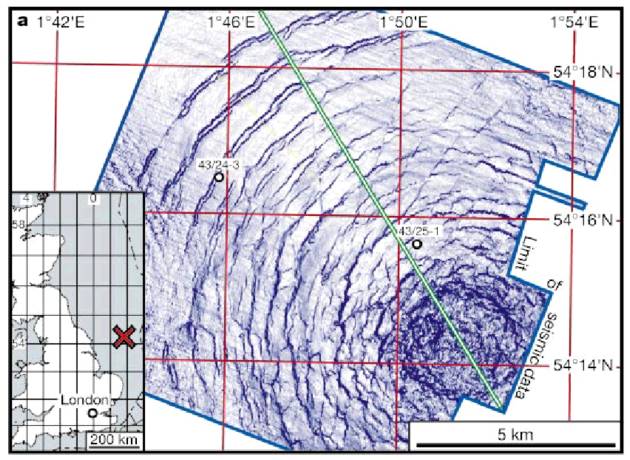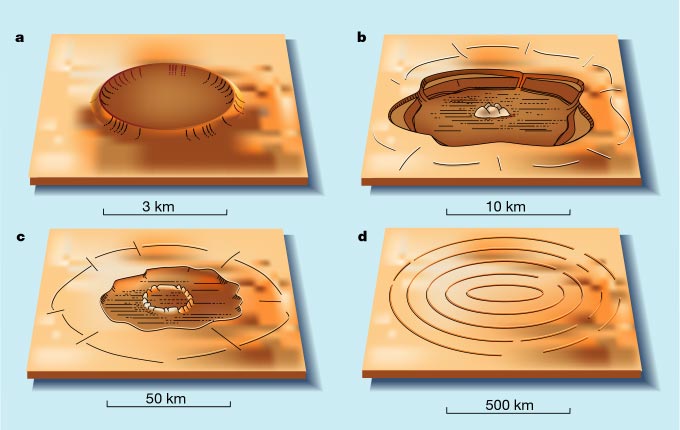Silverpit

Location and seismic map of the Silverpit crater. Darker areas show steeper slopes.
Illustration: Nature/BP/PGL

August 1, 2001
ANCIENT METEOR CRATER DISCOVERED BENEATH THE NORTH SEA
British petroleum geoscientist have mapped a small but
extraordinary well-preserved crater formed by a meteorite that
impacted Earth 60 to 65 million years ago.
The so-called Silverpit Crater, buried beneath the North Sea's rich oil and gas fields off England's eastern seaboard, measures 10 kilometers wide and sits beneath 36 meters of seawater and 270 meters of sediment.
"We know little about how impact structures are created when meteorites and comets hit," comments University of New Brunswick geologist John G. Spray, of the Impact Geology Group of the University of New Brunswick, who reviewed the crater data for the British journal Nature.

The main types of impact structure,
as currently defined from studies of the Earth and Moon. a, At the
smallest scale is the simple bowlshaped crater. b-d, At larger scales,
more complex structures are evident. b, Central peak; c, peak ring; d, multi-ring.
Illustration: courtesy John Spray
Silverpit's main crater is 2.4 kilometers wide with a central peak that probably formed when the Earth rebounded from the impact of the incoming cosmic projectile (isostasis). A series of at least 10 concentric impact rings radiate beyond it.
The Silverpit crater was identified by Britisch petroleum geoscientists Simon A. Stewart of BP, Aberdeen and Philip J. Allen of Production Geoscience Ltd., Banchory, reviewing seismic data collected 130 kilometers offshore from the Humber estuary. They mapped the crater's features using three-dimensional computer imaging normally reserved to plan energy drilling.
It is believed that Silverpit crater was formed after the catastrophic impact near Mexico's Yucatan Peninsula that contributed to the extinction of the dinosaurs.
"The real test that Silverpit was created by an impact will be to look for shock effects in the rocks that form it," says Spray. "Shock-generated features such as unusual microscopic mineral deformations and shatter cones (conical fracture systems formed by shock waves in rock) would be compelling evidence of an impact origin. Two wells that were drilled in the search for oil and gas do penetrate the structure, but unfortunately, few samples of the drill cuttings from them were taken. Given that impact structures are among the most productive hydrocarbon sites on the planet, we may get more rock samples if Silverpit shows exploration potential."
Carl Koppeschaar
Scientific American, 1 augustus 2002:
Ancient Crater Discovered Beneath the North Sea
Space.com, 31 juli 2002:
Study: Newfound Crater Under North Sea Carved by Asteroid
Ananova
July 31, 2002
60m-year-old meteor crater mapped in North Sea
Scientists have mapped a small but well-preserved crater in the North
Sea formed by a meteorite they believe smacked into Earth 60 to 65
million years ago.
The impact crater measures about six miles wide and sits beneath 120 feet of seawater and more than 900 feet of sediment.
Researchers believe the so-called Silverpit crater was formed after the catastrophic impact near Mexico's Yucatan Peninsula that scientists suspect contributed to the extinction of the dinosaurs.
"We know so little about how impact structures are created when meteorites and comets hit," said University of New Brunswick geologist John G. Spray, who reviewed the crater data for the journal Nature, which published details in its current issue. "Any new example helps."
 Back to ASTRONET's home page
Back to ASTRONET's home page